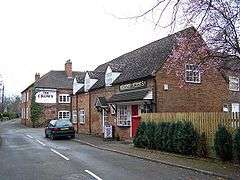Elford
| Elford | |
 Elford Stores |
|
 Elford |
|
| Population | 632 (2011)[1] |
|---|---|
| OS grid reference | SK189105 |
| Civil parish | Elford |
| District | Lichfield |
| Shire county | Staffordshire |
| Region | West Midlands |
| Country | England |
| Sovereign state | United Kingdom |
| Post town | TAMWORTH |
| Postcode district | B79 |
| Dialling code | 01827 |
| Police | Staffordshire |
| Fire | Staffordshire |
| Ambulance | West Midlands |
| EU Parliament | West Midlands |
| UK Parliament | Tamworth[2] |
|
|
Coordinates: 52°41′N 1°43′W / 52.69°N 1.72°W
Elford is a village and civil parish[3] in Lichfield District, Staffordshire, England.[4] It is situated on the east bank of the River Tame, about 5 miles (8 km) east of the City of Lichfield and 5 miles north of Tamworth.
Origins
The village is said to have derived its name from the great number of eels with which the river here formerly abounded. Before the Norman conquest this manor belonged to Ælfgār, Earl of Mercia. In the reign of Henry III, it was held by William de Arderne, whose descendants continued to enjoy it till the marriage of Maud, sole heiress of Sir John Arderne, with Thomas, second son of Sir John Stanley, of Latham, carried it into that family.
Buildings
Elford Hall was a mansion, erected about 1758. The Hall and much of the surrounding land was bequeathed, unexpectedly and much to the chagrin of his family, by the owner Mr Paget to 'the People of Birmingham'. It was intended to be used as leisure facilities or for day trips for the people of Birmingham. By the 1960s, it was torn down. Few reminders of it remain today, but those which do, including a walled garden, are currently the subject of demands for a return to 'the People of Elford'.
Elford House, a Victorian property remains. Elford House was built by the Webb family in the late 19th century. The initials of some family members can still be seen engraved into the wall near the rear patio.
St Peter's Church is the village church. The church is a Grade II* Listed Building. A church has stood on the current site since Norman times but the current building predominantly dates from the mid-19th century.
Robert Bage (1730–1801) owned a paper mill, and lived in the Mill House, built 1760. He wrote six novels including Man as he is (1792) and Hermsprong or Man as he is not (1796) which were much admired by Sir Walter Scott. Elford experienced its largest and most damaging floods in living memory on Fathers' Day 2007. The police, fire service, the district council, environmental agencies and even the army were all present to lend a hand. Nevertheless, many houses were severely damaged, including the paper mill, (recently converted to a dwelling), referred to above. The Mill house did not suffer as it is considerably elevated in relation to the Mill.
Surrounding countryside
Elford Lowe, on the summit of a hill, about one mile east of the village, is distinguished by a large oak tree and opposite it, at the distance of a mile, is a smaller lowe. These lowes have been known as 'Robin Hood's Shooting Butts', from a belief, that he sometimes practised here, and was able to shoot an arrow between them.
References
- ↑ "Civil Parish population 2011". Retrieved 7 December 2015.
- ↑ "United Kingdom Parliament". Retrieved 18 September 2009.
- ↑ "Names and codes for Administrative Geography". Office for National Statistics. 31 December 2008. Retrieved 15 September 2009.
- ↑ OS Explorer Map 232 : Nuneaton & Tamworth: (1:25 000) :ISBN 0 319 46404 0
External links
| Wikimedia Commons has media related to Elford. |